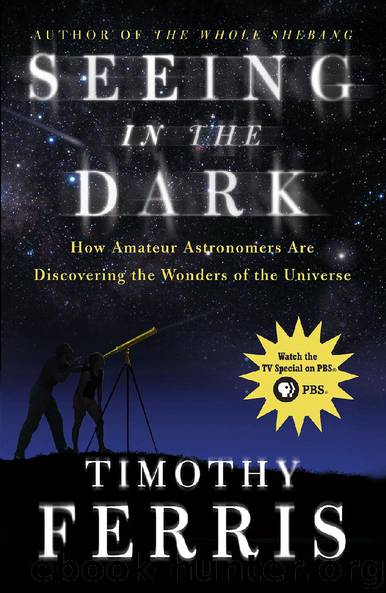Seeing in the Dark by Timothy Ferris

Author:Timothy Ferris
Language: eng
Format: epub
Publisher: Simon & Schuster
14.
The Outer Giants
Spring night—one hour worth a thousand gold coins . . .
—Su Tung-P’o
The hidden harmony is better than the obvious one.
—Heraclitus
ON A WET DECEMBER EVENING in 1997, I set up a small telescope on the deck of my house in San Francisco to watch the Moon pass in front of Saturn. This is an old pastime for human stargazers, dating back to at least 650 B.C., when a cuneiform inscription by Babylonian astronomers reports that “Saturn entered the Moon.” 1 Tonight’s occultation was predicted for 11:18 local time. It looked like Saturn would disappear behind the house before then, but I couldn’t climb the vertical steel ladder to the roof while carrying the telescope, and it was too slippery to ask my wife or son to help, so I left the telescope where it was, showed my son Saturn through it, and described the occultation that I hoped to observe after he’d gone to bed. His response was pleasingly undoctrinaire: “What would we think if Saturn passed in front of the Moon instead of the other way round?”
As the appointed time drew near, the Moon and Saturn had indeed disappeared behind the house, but by jamming the telescope’s tripod into the northeast corner of the deck and extending its legs to their maximum height, I managed to sight through a tunnel between the roof and the windblown branches of a tree. Although a nearby streetlamp flooded the scene, by pressing close to the eyepiece I could shut out most of the stray light.
There, sure enough, was Saturn with its incomparable rings, the moist air turning its color to that of an old doubloon seen through brown river water, with the stately cold white gibbous Moon almost on top of it. Moments later, the western end of the rings started to be eaten away by the total blackness of the lunar dark side. Soon the disk, too, was being bit into, like a vanilla tea biscuit, and was gone. Then the last of the rings was swallowed up, and there was nothing to be seen but the Moon. I looked at the watch: It had happened right on time. How Kepler would have envied modern astronomical computation.
AS I WRITE THIS, on a chill November evening in the year 2000, the giants are in the sky. Out the window I can see Saturn, glowing a dull tarnished bronze, with brighter Jupiter climbing in the east just twenty minutes behind it. (Such a close conjunction of the Sun’s two largest planets occurs only about once every twenty years. I was a high school student when I first saw one, a thirty-seven-year-old bachelor when the next one rolled around, and now I’m an emeritus professor with a wife and son. If I survive to see another conjunction of Jupiter and Saturn I’ll be pushing eighty.) Uranus and Neptune are sinking in the west tonight, their slow-grinding clockwork reminding me that Uranus, the god of heaven, was the father of time. Saturn takes almost thirty years to complete one orbit of the Sun, Uranus eighty-four years, and Neptune 165 years.
Download
This site does not store any files on its server. We only index and link to content provided by other sites. Please contact the content providers to delete copyright contents if any and email us, we'll remove relevant links or contents immediately.
| Aeronautics & Astronautics | Astronomy |
| Astrophysics & Space Science | Comets, Meteors & Asteroids |
| Cosmology | Mars |
| Solar System | Star-Gazing |
| Telescopes | UFOs |
Tools of Titans by Timothy Ferriss(8311)
Turbulence by E. J. Noyes(7983)
Secrets of Antigravity Propulsion: Tesla, UFOs, and Classified Aerospace Technology by Ph.D. Paul A. Laviolette(5336)
Astrophysics for People in a Hurry by Neil DeGrasse Tyson(5153)
Room 212 by Kate Stewart(5075)
Design of Trajectory Optimization Approach for Space Maneuver Vehicle Skip Entry Problems by Runqi Chai & Al Savvaris & Antonios Tsourdos & Senchun Chai(5040)
Pale Blue Dot by Carl Sagan(4960)
The David Icke Guide to the Global Conspiracy (and how to end it) by David Icke(4659)
A Journey Through Divination and Astronomy by Publishing Pottermore(4364)
Goodbye Paradise(3767)
Apollo 8 by Jeffrey Kluger(3673)
COSMOS by Carl Sagan(3593)
The Five People You Meet in Heaven by Mitch Albom(3522)
Losing the Nobel Prize by Brian Keating(3521)
How to Read Water: Clues and Patterns from Puddles to the Sea (Natural Navigation) by Tristan Gooley(3434)
Brief Answers to the Big Questions by Stephen Hawking(3394)
How to Read Nature by Tristan Gooley(3294)
The Order of Time by Carlo Rovelli(3164)
A Brief History of Time by Stephen Hawking(2994)
